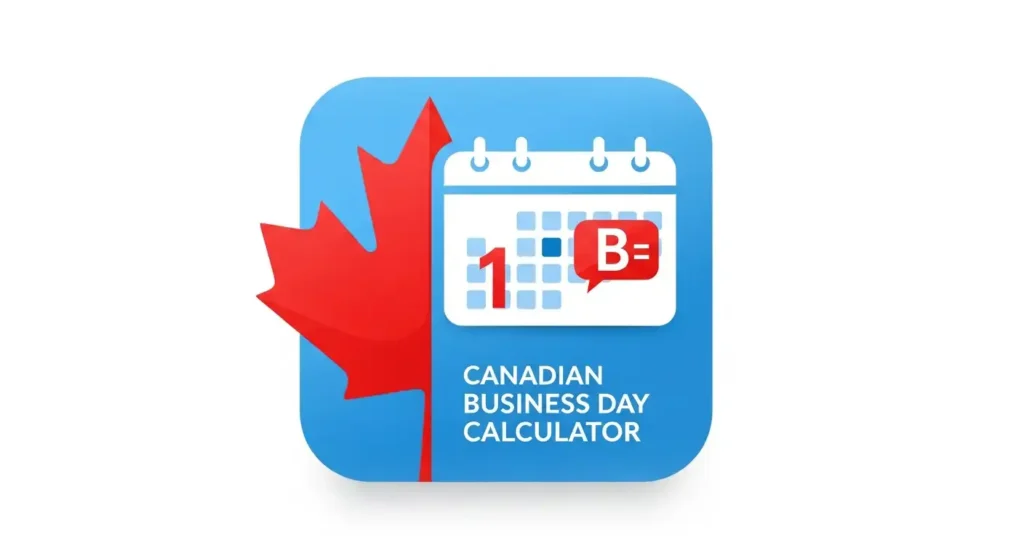Free Canadian Business Day Date Calculator
Canadian Business Day Calculator
The calculated end date is:
Found our free Canadian Business Day Date Calculator useful? Bookmark and share it.

Guide to Canadian Statutory Holidays
Navigating the complex world of Canadian statutory holidays is a significant challenge for any business. With a mix of national, federal, and provincial holidays, ensuring compliance with payroll regulations and managing employee entitlements can be daunting. This comprehensive guide provides a ten-year analysis of all Canadian federal and provincial holidays, helping your business plan effectively, maintain compliance, and manage payroll with confidence. Understanding these holidays is crucial for accurate scheduling, calculating statutory holiday pay, and fostering a positive work environment.
TL;DR
Canada's holiday system is a complex mix of five national holidays, additional federal holidays for specific sectors, and a diverse array of provincial and territorial holidays. This reflects Canada's federal structure and results in significant regional variation. For businesses, this means that managing payroll and employee entitlements for statutory holiday pay requires careful attention to the specific laws of each jurisdiction. Recent changes, like the introduction of the National Day for Truth and Reconciliation, show the calendar is evolving to reflect modern Canadian values. This guide provides a definitive ten-year holiday calendar (2025-2034) and a detailed breakdown of the rules for each province to help businesses ensure compliance and strategic planning.
Article Contents
- The Canadian Holiday Tapestry: An Overview
- The Pillars of the Canadian Calendar: National & Federal Holidays
- A Nation of Regions: Provincial and Territorial Holidays
- The Legal and Employment Framework
- The Evolving Calendar: Commemoration and Multiculturalism
- A 10-Year Outlook: Canadian Holiday Calendar (2025-2034)
- Conclusion: Insights and Future Trajectories
The Canadian Holiday Tapestry: An Overview
Understanding the Canadian holiday calendar requires a foundational knowledge of the legal and cultural structures that govern days of observance. Canada's system is a complex tapestry woven from federal, provincial, and territorial legislation, supplemented by deeply ingrained cultural traditions. This tiered structure is a direct consequence of the division of powers outlined in the Canadian Constitution.
Defining the Tiers of Observance
The term "holiday" in Canada encompasses several distinct categories, each with different legal implications for employers and employees.
National Statutory Holidays
At the core of the Canadian calendar are five statutory holidays observed nationwide in every province and territory. These are New Year's Day, Good Friday, Canada Day, Labour Day, and Christmas Day. These holidays form the bedrock of statutory time off for the vast majority of Canadian workers.
Federal Statutory Holidays
The federal government, through the Canada Labour Code, designates a broader list of statutory holidays for employees in federally regulated industries (e.g., banking, air transportation, telecommunications). This list includes the five national holidays plus Easter Monday, Victoria Day, Thanksgiving Day, Remembrance Day, Boxing Day, and the National Day for Truth and Reconciliation. While not mandatory for all businesses, this federal list often sets a precedent for provinces and private employers.
Provincial and Territorial Statutory Holidays
Each province and territory has the authority to legislate its own public holidays, leading to significant regional variations. Provinces may adopt federal holidays, create unique ones like Family Day in Ontario or Saint-Jean-Baptiste Day in Quebec, or not recognize certain federal holidays as paid days off.
Optional and Civic Holidays
Further complicating the landscape are optional or "civic" holidays. The most prominent example is the first Monday in August. In some provinces, like British Columbia (B.C. Day), it's a statutory holiday. In others, like Ontario, it is widely observed but its status as a paid day off is at the employer's discretion.
Commemorative Days and Non-Statutory Celebrations
Canada also officially recognizes many commemorative days (e.g., Black History Month) and celebrates numerous cultural and religious festivals (e.g., Diwali, Lunar New Year). While integral to Canada's social fabric, these are not statutory holidays and do not require a paid day off from work.
Master Guide to Statutory Holidays by Jurisdiction
The following table provides a foundational roadmap to the statutory holiday landscape across all Canadian jurisdictions.
| Holiday Name | Federal | AB | BC | MB | NB | NL | NS | NT | NU | ON | PE | QC | SK | YT |
|---|---|---|---|---|---|---|---|---|---|---|---|---|---|---|
| New Year's Day (Jan 1) | ✓ | ✓ | ✓ | ✓ | ✓ | ✓ | ✓ | ✓ | ✓ | ✓ | ✓ | ✓ | ✓ | ✓ |
| Islander Day (3rd Mon in Feb) | ✓ | |||||||||||||
| Louis Riel Day (3rd Mon in Feb) | ✓ | |||||||||||||
| Heritage Day (3rd Mon in Feb) | ✓ | |||||||||||||
| Family Day (3rd Mon in Feb) | ✓ | ✓ | ✓ | ✓ | ✓ | ✓ | ||||||||
| St. Patrick's Day (Mar 17) | ✓ | |||||||||||||
| Good Friday (varies) | ✓ | ✓ | ✓ | ✓ | ✓ | ✓ | ✓ | ✓ | ✓ | ✓ | ✓ | ✓ | ✓ | ✓ |
| Easter Monday (varies) | ✓ | ✓ | ✓ | ✓ | ||||||||||
| St. George's Day (varies) | ✓ | |||||||||||||
| Victoria Day / National Patriots' Day (Mon preceding May 25) | ✓ | ✓ | ✓ | ✓ | ✓ | ✓ | ✓ | ✓ | ✓ | ✓ | ✓ | ✓ | ||
| National Indigenous Peoples Day (Jun 21) | ✓ | ✓ | ||||||||||||
| Saint-Jean-Baptiste Day (Jun 24) | ✓ | |||||||||||||
| Canada Day (Jul 1) | ✓ | ✓ | ✓ | ✓ | ✓ | ✓ | ✓ | ✓ | ✓ | ✓ | ✓ | ✓ | ✓ | ✓ |
| Nunavut Day (Jul 9) | ✓ | |||||||||||||
| Civic Holiday (1st Mon in Aug) | ✓ | ✓ | ✓ | ✓ | ✓ | |||||||||
| Discovery Day (3rd Mon in Aug) | ✓ | |||||||||||||
| Labour Day (1st Mon in Sep) | ✓ | ✓ | ✓ | ✓ | ✓ | ✓ | ✓ | ✓ | ✓ | ✓ | ✓ | ✓ | ✓ | ✓ |
| National Day for Truth and Reconciliation (Sep 30) | ✓ | ✓ | ✓ | ✓ | ✓ | ✓ | ✓ | ✓ | ||||||
| Thanksgiving Day (2nd Mon in Oct) | ✓ | ✓ | ✓ | ✓ | ✓ | ✓ | ✓ | ✓ | ✓ | ✓ | ✓ | ✓ | ||
| Remembrance Day (Nov 11) | ✓ | ✓ | ✓ | ✓ | ✓ | ✓ | ✓ | ✓ | ✓ | ✓ | ||||
| Christmas Day (Dec 25) | ✓ | ✓ | ✓ | ✓ | ✓ | ✓ | ✓ | ✓ | ✓ | ✓ | ✓ | ✓ | ✓ | ✓ |
| Boxing Day (Dec 26) | ✓ | ✓ | ||||||||||||
| Note: This table reflects statutory paid holidays. Observance practices may vary. Quebec employers can choose between Good Friday or Easter Monday. Manitoba observes Orange Shirt Day on Sep 30. | ||||||||||||||
The Pillars of the Canadian Calendar: National & Federal Holidays
The holidays observed at the national and federal levels form the foundational structure of the Canadian calendar. They are commemorative pillars that narrate the country's political evolution, its religious heritage, and the struggles of its working people.
Canada Day (July 1): From Dominion to Nation
Canada's national day commemorates the enactment of the British North America Act, 1867. Originally named "Dominion Day," it was officially renamed "Canada Day" in 1982, symbolizing the nation's full sovereignty. Today, while it is a day of widespread celebration, it is also a day of solemn reflection for many Indigenous peoples, who view it as a reminder of colonization. In Newfoundland and Labrador, July 1 is also Memorial Day, honouring soldiers lost in the Battle of Beaumont-Hamel.
Victoria Day / National Patriots' Day (Monday preceding May 25): A Tale of Two Solitudes
This May long weekend highlights Canada's historical duality. Most of the country observes Victoria Day, Canada's oldest state holiday, celebrating the sovereign's birthday. In Quebec, however, the same day is Journée nationale des patriotes (National Patriots' Day), honouring the 1837–38 rebellion against British rule. It’s a powerful symbol of the different historical narratives coexisting within Canada.
Labour Day (First Monday in September): A Holiday Forged in Protest
Born from the Toronto printers' strike of 1872 for a nine-hour workday, Labour Day is uniquely North American. The protests led to the Trade Union Act, decriminalizing union activity. Today, while still a day for celebrating workers' rights, for most it marks the unofficial end of summer.
Thanksgiving Day (Second Monday in October): A Layered History
Canadian Thanksgiving blends Indigenous harvest traditions with European practices. The first recorded Thanksgiving by Europeans was in 1578 by explorer Martin Frobisher. It was formally established as a national holiday in 1879 and fixed to its current date in 1957. It is primarily a secular holiday focused on family gatherings and a harvest feast. It is not a statutory holiday in the Atlantic provinces of PEI, New Brunswick, and Nova Scotia, though it is widely observed.
Remembrance Day (November 11): A Day of Solemn Commemoration
Remembrance Day honours members of Canada's armed forces who have died in the line of duty. It marks the armistice that ended World War I at 11:00 a.m. on November 11, 1918. Traditions include two minutes of silence and the wearing of the red poppy. Critically for employers, while it is a federal statutory holiday, it is not a statutory paid day off for provincially regulated workers in Ontario, Quebec, Manitoba, and Nova Scotia.
The Easter Period (Good Friday & Easter Monday): Religious and Secular Observance
Good Friday is a national statutory holiday, commemorating the crucifixion of Jesus Christ. Easter Monday is a statutory holiday only for federal employees and in Quebec. The weekend blends solemn religious observance with secular traditions like Easter egg hunts, celebrating the arrival of spring.
Other Federal Holidays (New Year's Day, Christmas Day, Boxing Day)
New Year's Day (January 1) and Christmas Day (December 25) are national statutory holidays. Boxing Day (December 26) is a statutory holiday for federally regulated employees and in Ontario. In modern Canada, it is primarily known as the biggest retail shopping day of the year.
A Nation of Regions: Provincial and Territorial Holidays
The unique statutory holidays legislated by provinces and territories give the Canadian calendar its distinct regional character, reflecting local histories, cultures, and priorities.
The February Holidays: A Mid-Winter Break
Recognizing the long stretch between New Year's and Good Friday, eight provinces have independently established a holiday in February. This includes Family Day (in AB, SK, ON, BC, NB), Louis Riel Day in Manitoba (honouring the province's Métis founder), Islander Day in PEI, and Heritage Day in Nova Scotia.
Celebrating Quebec: Fête Nationale and Patriots' Day
Quebec's calendar is the most distinct. Saint-Jean-Baptiste Day (June 24) was transformed into the Fête nationale du Québec, the primary celebration of Québécois identity. As noted, National Patriots' Day replaces Victoria Day, commemorating resistance to British rule.
The Civic Holiday: The Unnamed Long Weekend (First Monday in August)
This summer long weekend takes on various local identities. It is a statutory holiday in several jurisdictions, known as B.C. Day in British Columbia, Saskatchewan Day in Saskatchewan, and New Brunswick Day in New Brunswick. In Ontario and Alberta, it is widely observed but is not a statutory paid day off.
Northern and Indigenous Observances
The territories' calendars reflect their unique histories. National Indigenous Peoples Day (June 21), the summer solstice, is a statutory holiday in the Northwest Territories and Yukon. Nunavut Day (July 9) is unique to Nunavut, commemorating the passage of the Nunavut Land Claims Agreement Act.
The Legal and Employment Framework
Statutory holidays have critical implications for employers. The legal framework governing eligibility, pay calculation, and premium compensation varies significantly between jurisdictions, creating compliance risks for national employers.
General Principles of Holiday Pay
Despite differences, core principles generally apply. Eligible employees get a paid day off. If they work, they typically receive holiday pay plus a premium wage (usually 1.5 times their regular rate). If the holiday falls on a non-working day, employees are usually entitled to another day off with pay.
Jurisdictional Deep Dive: A Comparative Analysis
The following table provides a comparative analysis of the key regulations governing statutory holiday pay across Canada.
| Jurisdiction | Eligibility Criteria | Holiday Pay Formula (for a day off) | Premium Pay Formula (for working) |
|---|---|---|---|
| Federal | Employed for at least 30 days. | 1/20th of wages (excl. overtime) from the 4 weeks prior. | Holiday Pay + 1.5x regular rate for hours worked. |
| Alberta (AB) | Worked for employer 30+ workdays in last 12 months. Must work scheduled shifts before/after. | Average daily wage from the 4 weeks prior. | EITHER: Holiday Pay + 1.5x rate, OR Regular pay + a future paid day off. |
| British Columbia (BC) | Employed 30 calendar days, and worked/earned wages on 15 of 30 days prior. | "Average day's pay": Total wages (excl. OT) in 30 days prior / days worked. | Holiday Pay + 1.5x rate for first 12 hrs, 2x rate thereafter. |
| Manitoba (MB) | No unexcused absence on workday before/after. | 5% of gross wages (excl. OT) in 4 weeks prior. | Holiday Pay + 1.5x regular rate for hours worked. |
| New Brunswick (NB) | Employed 90 calendar days in 12 months prior. Must work scheduled shifts before/after. | A regular day's pay. | Holiday Pay + 1.5x regular rate for hours worked. |
| Newfoundland & Labrador (NL) | Employed 30 calendar days. Must work scheduled shifts before/after. | A regular day's pay. | EITHER: 2x rate, OR Regular pay + future paid day off, OR Regular pay + extra vacation day. |
| Nova Scotia (NS) | Employed 15 of 30 days prior. Must work scheduled shifts before/after. | A regular day's pay. | Holiday Pay + 1.5x regular rate for hours worked. |
| Ontario (ON) | Must work last scheduled shift before and first after ("last and first rule"). | Total regular wages + vacation pay from 4 weeks prior / 20. | EITHER: Regular pay + substitute paid day off, OR Holiday Pay + 1.5x rate (with agreement). |
| Prince Edward Island (PEI) | Employed 30 days. Earned pay on 15 of 30 days prior. Work shifts before/after. | A regular day's pay. | Holiday Pay + 1.5x regular rate for hours worked. |
| Quebec (QC) | No service requirement. Not absent without cause on workday before/after. | 1/20th of wages from 4 full weeks prior. | Regular pay for hours worked + Holiday Pay (or a substitute day off). |
| Saskatchewan (SK) | No service requirement. | 5% of wages from 4 weeks prior. | Holiday Pay + 1.5x regular rate for hours worked. |
The Evolving Calendar: Commemoration and Multiculturalism
The Canadian calendar is not static; it is an active arena where groups advocate for recognition. Recent changes demonstrate a clear trajectory toward a more inclusive and representative calendar.
A New Pillar: The National Day for Truth and Reconciliation (September 30)
Established in 2021, this federal holiday is the most significant change to the calendar in decades. It responds to the Truth and Reconciliation Commission's Call to Action #80, creating a day for solemn reflection on the history and legacy of residential schools. Its purpose is not celebration but atonement. However, its adoption as a statutory holiday at the provincial level has been uneven, with provinces like Ontario, Quebec, and Alberta not yet mandating it as a paid day off for all workers.
The Influence of Multiculturalism
As Canada diversifies, so does its calendar. Traditional holidays like Canada Day now showcase global cultures. Furthermore, there is growing public celebration of non-statutory holidays like Chinese New Year, Diwali, and Eid al-Fitr. In response, many companies now offer "floating holidays," allowing employees to take a paid day off for cultural or religious observances not on the official calendar. This flexibility is a market-based solution to the rigidity of a fixed statutory holiday list.
A 10-Year Outlook: Canadian Holiday Calendar (2025-2034)
This section provides a definitive, year-by-year calendar of all national, federal, provincial, and territorial statutory holidays for the next decade. It is an essential tool for long-range planning, budgeting, and compliance.
Methodology for Date Calculation
Dates are calculated based on fixed dates (e.g., Canada Day), formulas (e.g., Labour Day), or the ecclesiastical calendar (e.g., Good Friday). A "weekend observance rule" is applied: when a fixed-date holiday falls on a weekend, the paid day off is typically observed on the following Monday.
Annual Holiday Tables (2025-2034)
Canadian Statutory Holidays, 2025
| Date | Day | Holiday Name | Jurisdiction(s) of Observance |
|---|---|---|---|
| Jan 1 | Wednesday | New Year's Day | National |
| Feb 17 | Monday | Family Day | AB, BC, NB, ON, SK |
| Feb 17 | Monday | Louis Riel Day | MB |
| Feb 17 | Monday | Islander Day | PE |
| Feb 17 | Monday | Heritage Day | NS |
| Mar 17 | Monday | St. Patrick's Day | NL |
| Apr 18 | Friday | Good Friday | National |
| Apr 21 | Monday | Easter Monday | Federal, QC, NT |
| Apr 21 | Monday | St. George's Day (Observed) | NL |
| May 19 | Monday | Victoria Day / National Patriots' Day | Federal, AB, BC, MB, NT, NU, ON, QC, SK, YT |
| Jun 21 | Saturday | National Indigenous Peoples Day | NT, YT |
| Jun 23 | Monday | Discovery Day (Observed) | NL |
| Jun 24 | Tuesday | Saint-Jean-Baptiste Day | QC |
| Jul 1 | Tuesday | Canada Day | National |
| Jul 9 | Wednesday | Nunavut Day | NU |
| Jul 14 | Monday | Orangemen's Day (Observed) | NL |
| Aug 4 | Monday | Civic Holiday | BC, NB, SK, NT, NU |
| Aug 18 | Monday | Discovery Day | YT |
| Sep 1 | Monday | Labour Day | National |
| Sep 30 | Tuesday | National Day for Truth and Reconciliation | Federal, BC, MB, NB, NT, NU, PE, YT |
| Oct 13 | Monday | Thanksgiving Day | Federal, AB, BC, MB, NT, NU, ON, SK, YT |
| Nov 11 | Tuesday | Remembrance Day | Federal, AB, BC, NB, NL, NT, NU, PE, SK, YT |
| Dec 25 | Thursday | Christmas Day | National |
| Dec 26 | Friday | Boxing Day | Federal, ON, NL |
Conclusion: Insights and Future Trajectories
The Canadian holiday calendar is more than a schedule; it's a dynamic reflection of the nation's history, laws, and evolving identity. For businesses, navigating this landscape requires diligence and the right tools.
Synthesis of Findings
Our analysis shows three key themes: 1) Federalism in Action: The calendar is a direct result of Canada's constitutional division of powers, creating administrative complexity. 2) A National Narrative: The evolution of holidays charts Canada's journey from dominion to sovereign nation. 3) An Evolving Document: The calendar is actively being reshaped by forces of reconciliation and multiculturalism.
Future Trajectories and Unanswered Questions
Looking ahead, broader provincial adoption of the National Day for Truth and Reconciliation will be a key issue. The growing prominence of multicultural celebrations may also lead to future debates about adding new statutory holidays or adopting more flexible models. For businesses, the compliance burden created by the patchwork of provincial rules may lead to calls for greater harmonization of employment standards.
Simplify Your Canadian Payroll and Holiday Management
Tired of manually tracking different provincial stat holidays and calculating complex holiday pay? TimeTrex automates the entire process. Our all-in-one payroll management software handles statutory holiday calculations for every province and territory, ensuring your business stays compliant and your employees are paid accurately, every time. Save time, reduce errors, and focus on what you do best.
Learn More About TimeTrex PayrollDisclaimer: The content provided on this webpage is for informational purposes only and is not intended to be a substitute for professional advice. While we strive to ensure the accuracy and timeliness of the information presented here, the details may change over time or vary in different jurisdictions. Therefore, we do not guarantee the completeness, reliability, or absolute accuracy of this information. The information on this page should not be used as a basis for making legal, financial, or any other key decisions. We strongly advise consulting with a qualified professional or expert in the relevant field for specific advice, guidance, or services. By using this webpage, you acknowledge that the information is offered “as is” and that we are not liable for any errors, omissions, or inaccuracies in the content, nor for any actions taken based on the information provided. We shall not be held liable for any direct, indirect, incidental, consequential, or punitive damages arising out of your access to, use of, or reliance on any content on this page.
Trusted By
Trusted by 3.2M+ Employees: 21 Years of Service Across Startups to Fortune 500 Enterprises
Join our ever-growing community of satisfied customers today and experience the unparalleled benefits of TimeTrex.










Strength In Numbers
Join The Companies Already Benefiting From TimeTrex
Time To Clock-In
Start your 30-day free trial!
Experience the Ultimate Workforce Solution and Revolutionize Your Business Today
- Eliminate Errors
- Simple & Easy To Use
- Real-time Reporting

Saving businesses time and money through better workforce management since 2003.
Copyright © 2025 TimeTrex. All Rights Reserved.
